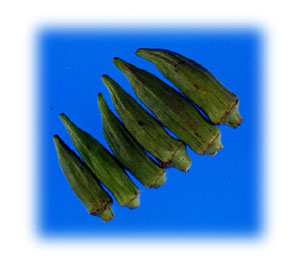Plant of the Week
by
David Rodriguez
 Okra (Abelmoschus esculentus) is a warm season vegetable which grows well in most South/Central Texas soils. For ample yields, okra must grow in full sunlight with eight hours minimum and in a well drained fertile soil.
Okra (Abelmoschus esculentus) is a warm season vegetable which grows well in most South/Central Texas soils. For ample yields, okra must grow in full sunlight with eight hours minimum and in a well drained fertile soil.
Soil Preparation
Spade or turn the soil as deeply as possible. Okra will grow best in soil which has been worked a minimum of eight-to-ten inches deep. Always, consider adding organically enriched and properly aged compost at the initial preparation stage for any vegetable crop at a minimum rate of one-to-two inches incorporated in the planting area. Remove any debris such as rocks or trash, and rake the soil to a leveled and smooth planting surface. Work the soil only when it is dry enough so as not to stick to garden tools.
Fertilizing
Before planting, use half a pound of fertilizer such as 19-5-9 synthetic analysis for each ten square feet of garden area. If an organic formulation is preferred, consider a 4-2-3 or a 6-2-2 analysis at a rate of two-to-three pounds per ten square feet of garden area. Spread the fertilizer evenly throughout the planting area. Mix it well into the top three-to-four inches of soil.
Varieties
” For direct Cajun Delight
” Emerald
” Clemson Spineless
” Lee
” Beck’s Big (May be harder to find)
For direct seed sources for the above suggested Cultivated Varieties, please visit this link at:
http://aggie-horticulture.tamu.edu/PLANTanswers/vegvar.html
Planting
For best yields, plant okra in the spring season two-to-three weeks after all danger of frost has passed, which is about late April or May for this area. For a good fall crop, plant at least three months (around the first part of August) before the first fall frost which can be as early as October 31st. Okra seed should be planted about 1 inch deep and 4 inches apart in the row. Space the rows at least 30-36 inches apart. As soon as the okra emerges and forms its second true leaves, thin the plants so that they are about 12-18 inches apart.
Watering
Okra will do fairly well under dry conditions. However, watering every seven-to-ten days will give higher yields. Sandy soils usually will need water more often than clay soils. Consider setting up a drip irrigation system. Such a system will provide a more efficient and consistent way to properly irrigate. A two inch layer of a pine or cedar mulch will also aide in cutting back on watering.
Helpful Growing Tips
Cultivate around the okra plants to remove any obnoxious weeds or grass. Hand pulling weeds close to the plants will avoid damaging the roots of the okra. After the first harvest, apply half-to-one cup of synthetic garden fertilizer (19-5-9) or two-to-three cups of organic fertilizer for every ten feet of row. Scatter the fertilizer evenly between the rows. Mix it lightly with the soil. Water the plants thoroughly after fertilizing.
Insects
Stink bug, aphids and ants can be damaging and a nuisance in growing okra. If one feels that a pesticide application is needed, consider the use of Spinosad which is an organic based product or synthetic Malathion which is more toxic. Before using any pesticide, read and understand the label. ALWAYS follow cautions, warnings and most importantly the directions.
Harvesting
The okra will produce large flowers about two months after planting. The okra pods will be ready to pick three-to-four days later. Harvest the pods when they are three-to-four inches long. If the okra gets too large, it will be tough and stringy. Pick the okra every one-to-two days or yields will be decreased, especially the first ones need to be harvested very insistently.
Serving
Okra is an expectable source of Vitamin A. It can be eaten in many ways, including boiled, fried and cooked in soups, gumbos and casseroles.
Storing
Okra can be stored for three-to-five days in the refrigerator. Okra which is too mature can be dried, cured and used in flower arrangements.
Clean-Up
Okra seed is easily saved for next season by leaving some of the last pods on the plant until they get very large. Remove them and allow them to dry. The seeds will shell easily from the pods. Other plant material such as leaves and stems can be put into the compost pile.
Remember, Learn and Have Fun!!
For more information on okra or any other vegetables, please contact David Rodriguez Extension Horticulturist with Texas Cooperative Extension for Bexar County or call the Master Gardener ‘Hotline’ at (210) 467-6575. Please, visit the County Extension website at: http://bexar-tx.tamu.edu, click under Horticulture and Gardening.